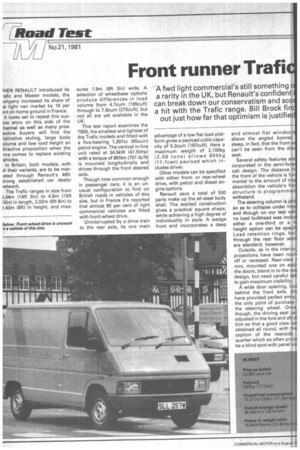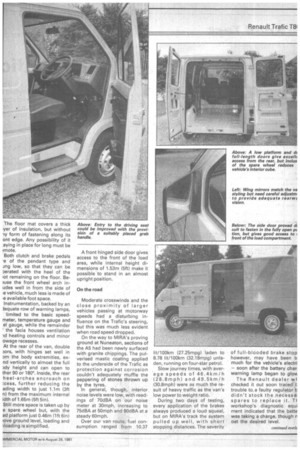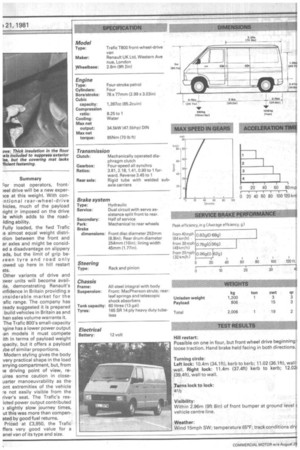Front runner Trafi
Page 18

Page 19

Page 20

If you've noticed an error in this article please click here to report it so we can fix it.
A fwd light commercial's still something a rarity in the UK, but Renault's confident can break down our conservatism and sco a hit with the Trafic range. Bill Brock fin
out just how far that optimism is justifie
THEN RENAULT introduced its -afic and Master models, the )mpany increased its share of le light van market by 16 per ?rit on home ground in France. It looks set to repeat this SUcDSS story on this side of the hannel as well as many prosective buyers will find the istinctive styling, large body olume and low load height an ttractive proposition when the me comes to replace existing ehicles.
In Britain, both models, with ill their variants, are to be mareted through Renault's 480;trong established car dealer ietwork.
The Trafic ranges in size from 1.34m (14ft 3in) to 4.8m (15ft 10in) in length, 2.02m (6ft Sin) to !.43m (8t) in height, and mea sures 1.9m (6ft 3in) wide. A selection of wheelbase options produce differences in load volume from 4.7cum (165cuft) through to 7.8cum (275cuft), but not all are yet available in the UK.
This test report examines the T800, the smallest and lightest of the Trafic models and fitted with a five-bearing 1,397cc (85cuin) petrol engine. The vertical in-line unit rated at 34.5kW (47.5bhp) with a torque of 95Nm (701 lb/ft) is mounted longitudinally and drives through the front steered axle.
Though now common enough in passenger cars, it is an unusual configuration to find on British roads in vehicles of this size, but in France it's reported that almost 80 per cent of light commercial vehicles are fitted with front-wheel drive.
Uninterrupted by a drive train to the rear axle, its one main advantage of a low flat load platform gives a payload cubic capacity of 5.3cum (187cuft). Here a maximum weight of 2,100kg (2.06 tons) allows 9 0 Okg (17.7cwt) payload which includes driver.
Other models can be specified with either frontor rear-wheel drive, with petrol and diesel engine options.
Renault says a total of 500 parts make up the all-steel body shell. The welded construction gives a practical square shape, while achieving a high degree of individuality in style. A wedge front end incorporates a deep and almost flat windscr above the angled bonnet, steep, in fact, that the front e can't be seen from the driv seat.
Several safety features are corporated in the semi-forw cab design. The distance fr the front of the vehicle is fun mental to the amount of im absorbtion the vehicle's fro structure is programmed withstand.
The steering column is joi so as to collapse under imp and though on our test veh no load bulkhead was inclu either a one-third or a f height option can be specif Load retention rings, bol through the rear floor sect are standard, however. Outside, as in the interiorj projections have been rouni off or recessed. Rear-view r rors, mounted one on each the doors, blend in to the ovE design, but need careful set to gain maximum visibility.
A wide door opening, locz behind the front axle, shc have provided perfect entry, the only point of purchase the steering wheel. Once though, the driving seat car adjusted in the fore and aft di tion so that a good view car obtained all round, with the ception of the nearside quarter which so often prow be a blind spot with panel The floor mat covers a thick yer of insulation, but without iy form of fastening along its ont edge. Any possibility of it eying in place for long must be :mote.
Both clutch and brake pedals -e of the pendant type and Jng low, so that they can be Derated with the heel of the lot remaining on the floor. Be:use the front wheel arch inudes well in from the side of e vehicle, much less is made of e available foot space.
Instrumentation, backed by an Jequate row of warning lamps, limited to the basic speedmeter, temperature gauge and el gauge, while the remainder the facia houses ventilation Id heating controls and minor owage recesses.
At the rear of the van, double )ors, with hinges set well in Dm the body extremities, exnd vertically to almost the full ady height and can open to ther 90 or 1800. Inside, the rear heel-arches encroach on ;cess, further reducing the ading width to just 1.1m (3f1 n) from the maximum internal idth of 1.65m (5ft 5in).
Still more space is taken up by e spare wheel but, with the ad platform just 0.46m Oft 6in) )ove ground level, loading and :loading is simplified. A front hinged side door gives access to the front of the load area, while internal height dimensions of 1.53m (5ft) make it possible to stand in an almost upright position.
On the road Moderate crosswinds and the close proximity of larger vehicles passing at motorway speeds had a disturbing influence on the Trafic's steering, but this was much less evident when road speed dropped.
On the way to MIRA's proving ground at Nuneaton, sections of the A5 had been newly surfaced with granite chippings. The pulverised mastic coating applied to the underside of the Trafic as protection against corrosion couldn't adequately muffle the peppering of stones thrown up by the tyres.
In general, though, interior noise levels were low, with readings of 70dBA on our noise meter at 30mph, increasing to 75dBA at 50mph and 80dBA at a steady 60mph.
Over our van route, fuel consumption ranged from 10.37 lit/100km (27.25mpg) laden to 8.78 lit/100km (32.18mpg) unladen, running on four-star petrol. , Slow journey times, with average speeds of 4 6.4 km/h (2 8.8mph) and 4 9. 5km/h (30.8mph) were as much the result of heavy traffic as the van's low power to weight ratio.
During two days of testing, every application of the brakes always produced a loud squeal, but on MIRA's track the system pulled up well, with short stopping distances. The severity
of full-blooded brake stop however, may have been t( much for the vehicle's electri — soon after the battery char, warning lamp began to glov:
The Renault dealer wf checked it out soon traced t trouble to. a faulty regulator b didn't stock the necessa spares to replace it. Ti workshop's diagnostic equi ment indicated that the batte was taking a charge, though r oat the desired level. Summary
or most operators, fronteel drive will be a new experIce at this weight. With conntional rear-wheel-drive hides, much of the payload ?ight iP imposed on the drive le which adds to the roadMing ability.
Fully loaded, the fwd Trafic Is almost equal weight distriition between the front and ar axles and might be consided a disadvantage on slippery ads, but the limit of grip beteen tyre and road only towed up here in hill restart sts.
Other variants of drive and )wer units will become avail)le, demonstrating Renault's
■ nfidence in Britain providing a )nsiderable market for the .afic range. The company has ready suggested it it prepared build vehicles in Britain as and hen sales volume warrants it. The Trafic 800's small-capacity 'gine has a lower power output an models it must compete ith in terms of payload weight ipacity, but it offers a payload the of similar proportions.
Modern styling gives the body very practical shape in the load )(Tying compartment, but, from te driving point of view, reLures some caution in closeuarter manoeuvrability as the ont extremities of the vehicle re not easily visible from the river's seat. The Trafic's resicted power output contributed ) slightly slow journey times, ut this was more than compenated by good fuel returns.
Priced at E3,950, the Trafic ffers very good value for a anel van of its type and size.




































